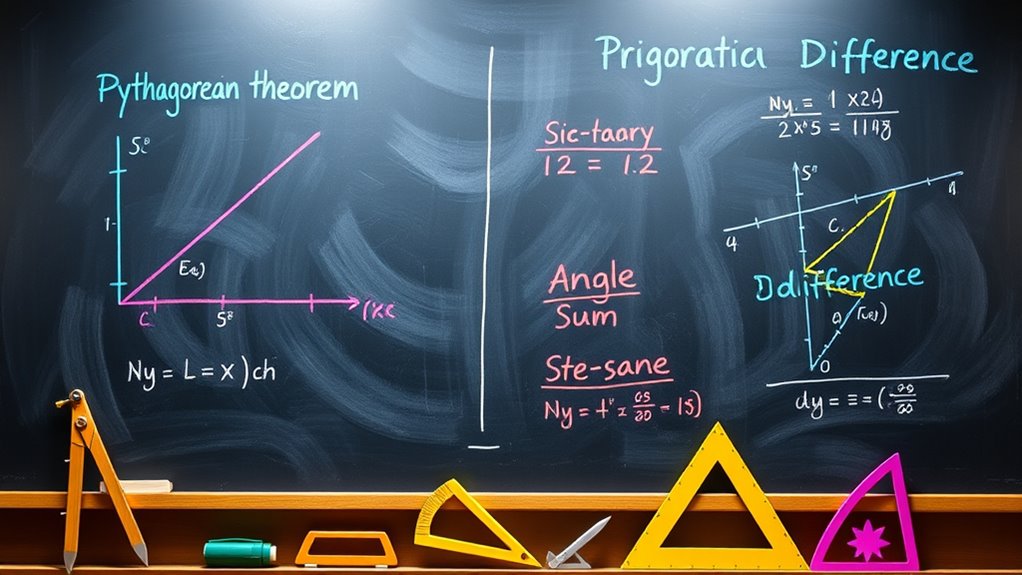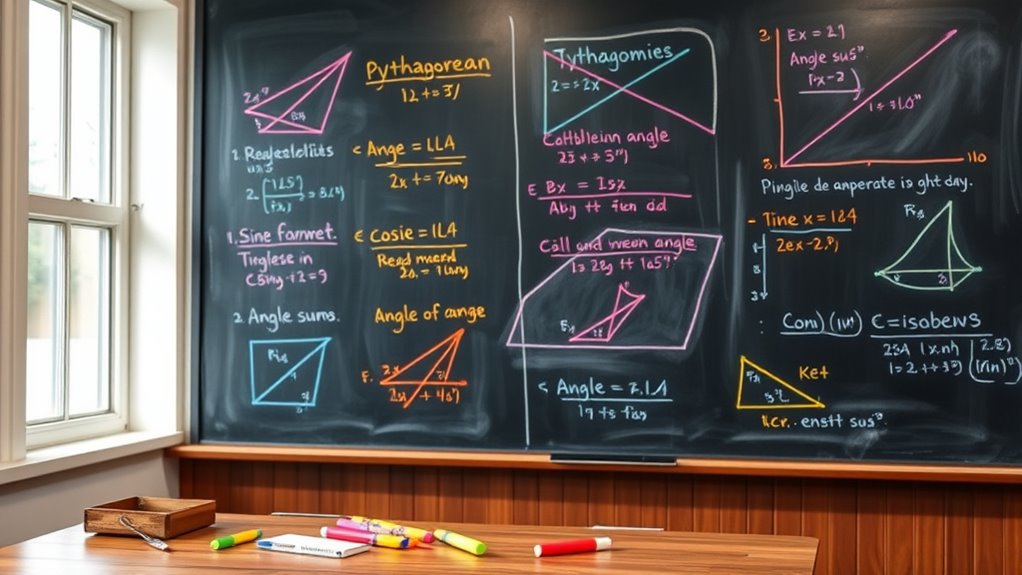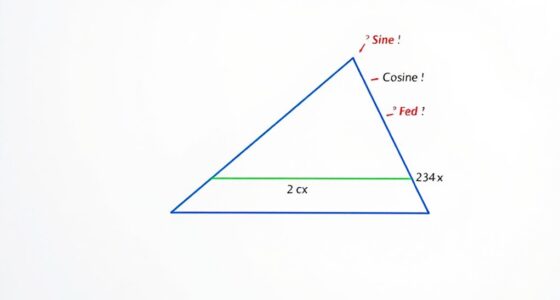Trig identities, like the Pythagorean theorem and angle sum formulas, connect angles and side ratios using geometric and algebraic principles. On the unit circle, sine, cosine, and their reciprocals relate through simple flipping of coordinates. Recognizing these relationships simplifies solving problems and verifying identities. As you explore how these formulas work together visually and algebraically, you’ll gain a deeper understanding of their significance—and discover more ways to apply them effectively.
Key Takeaways
- Pythagorean identities relate sine and cosine: sin²θ + cos²θ = 1, derived from the unit circle’s geometry.
- Angle sum identities, like sin(A+B) and cos(A+B), express trigonometric functions of combined angles using individual functions.
- Reciprocal identities connect functions: cscθ = 1/sinθ and secθ = 1/cosθ, simplifying complex expressions.
- Co-function identities reveal relationships between complementary angles, such as sin(90°−θ) = cosθ.
- These identities enable problem-solving by transforming and simplifying trigonometric expressions efficiently.

Have you ever wondered how mathematicians simplify complex trigonometric expressions? One of the most powerful tools they use is the unit circle, which provides a visual and algebraic foundation for understanding sine, cosine, and other trigonometric functions. The unit circle is a circle with a radius of one centered at the origin, and it allows you to relate angles to coordinates directly. When working with trigonometric identities, the unit circle makes it easier to recognize relationships between angles and their sine and cosine values. It’s especially helpful when dealing with reciprocal identities, which connect functions like sine and cosecant or cosine and secant. For example, on the unit circle, sine and cosecant are reciprocals of each other, so if you know the sine of an angle, you can find its cosecant by taking the reciprocal. Conversely, if you have the cosecant, you can find the sine by inverting it. This reciprocal relationship simplifies many expressions and calculations, saving you time and effort. Additionally, understanding how the radius of the circle relates to the values of sine and cosine enhances comprehension of these identities.
Understanding the unit circle also helps you see why reciprocal identities hold true. Since every point on the circle corresponds to an angle and its sine and cosine, recognizing that cosecant is the reciprocal of sine becomes straightforward—just flip the y-coordinate of the point on the circle. Similarly, secant is the reciprocal of cosine, which corresponds to flipping the x-coordinate. This visual perspective makes it easier to remember these identities and see their geometric significance. When simplifying more complicated expressions, you can often substitute these reciprocal identities to rewrite the expression in a more manageable form. For instance, converting a cosecant into 1/sin(θ) allows you to combine it with other functions or simplify the expression further.
Using the unit circle and reciprocal identities together enables you to approach trigonometric problems more confidently. They act as fundamental building blocks, helping you verify identities, solve equations, and evaluate functions quickly. Plus, understanding these identities enhances your grasp of the relationships between angles and their trigonometric values, which is essential for mastering more advanced topics in trigonometry. As you become more comfortable with the unit circle, you’ll find that many identities seem almost intuitive. Recognizing that sine and cosecant, cosine and secant, or tangent and cotangent are linked via reciprocal relationships simplifies your work considerably. It transforms what might seem like abstract formulas into clear, geometric concepts tied directly to the circle and its coordinates. With practice, you’ll start to see these identities everywhere, making your problem-solving faster and more accurate.
Frequently Asked Questions
How Do Trig Identities Apply in Real-World Engineering Problems?
You use trig identities in real-world engineering problems to simplify calculations, model physical systems, and improve accuracy. They help you analyze forces, vibrations, and wave patterns in structures, electronics, and robotics. By applying these identities, you find practical solutions more efficiently, ensuring safety and reliability. Whether designing bridges or circuits, trig identities are essential tools that enable you to solve complex engineering challenges quickly and precisely.
Are There Any Less Common Trig Identities I Should Know?
Ever wondered if there’s more to trig identities than what you usually see? Yes, there are less common identities and advanced formulas that can be incredibly useful. These include product-to-sum and sum-to-product formulas, hyperbolic identities, and even those involving inverse functions. Knowing these helps you tackle complex problems with elegance and confidence, expanding your mathematical toolkit beyond the basics and opening doors to deeper understanding and innovative solutions.
How Can I Memorize All the Basic Trig Identities Easily?
To memorize all the basic trig identities easily, use memorization techniques like flashcards and repeated practice. Mnemonic devices can help you remember complex formulas—consider creating catchy phrases or acronyms. Break down the identities into smaller groups, and review them regularly. Visual aids, like charts or diagrams, also reinforce your memory. Consistent practice and engaging with the material actively make retention much easier.
Do Trig Identities Vary Across Different Mathematical Fields?
Imagine you’re solving a physics problem and notice that sine and cosine formulas differ slightly in vector calculus. Trig identities do vary across mathematical frameworks, leading to identity variations tailored to each field’s needs. These differences help adapt trigonometry to contexts like calculus, physics, or engineering. So, while core identities stay consistent, their specific forms can change depending on the mathematical framework you’re working within.
What Are the Most Common Mistakes When Using Trig Identities?
When using trig identities, you often fall into misapplication pitfalls like applying the wrong identity or skipping steps. Simplification errors happen when you incorrectly reduce expressions or forget to take into account domain restrictions. To avoid these mistakes, double-check each step, verify identities before applying, and keep track of signs and conditions. Practice carefully, and you’ll reduce errors and improve your accuracy with trig functions.
Conclusion
Now that you understand key trig identities, you’re better equipped to solve complex problems. For example, imagine you’re working on a physics project involving angles and forces; knowing these identities can simplify your calculations and save time. Keep practicing, and soon you’ll see how these formulas become second nature. Remember, mastering trig identities not only boosts your math skills but also opens doors to understanding the world around you more deeply.









